Flycatchers are a delightful component of autumn passerine 'falls'. Three species – Spotted, Pied and Red-breasted – occur regularly on British coasts, but each also has a much rarer and rather similar counterpart species. This article covers the identification of our three familiar species and compares them with Asian Brown, Collared and Taiga Flycatchers respectively.
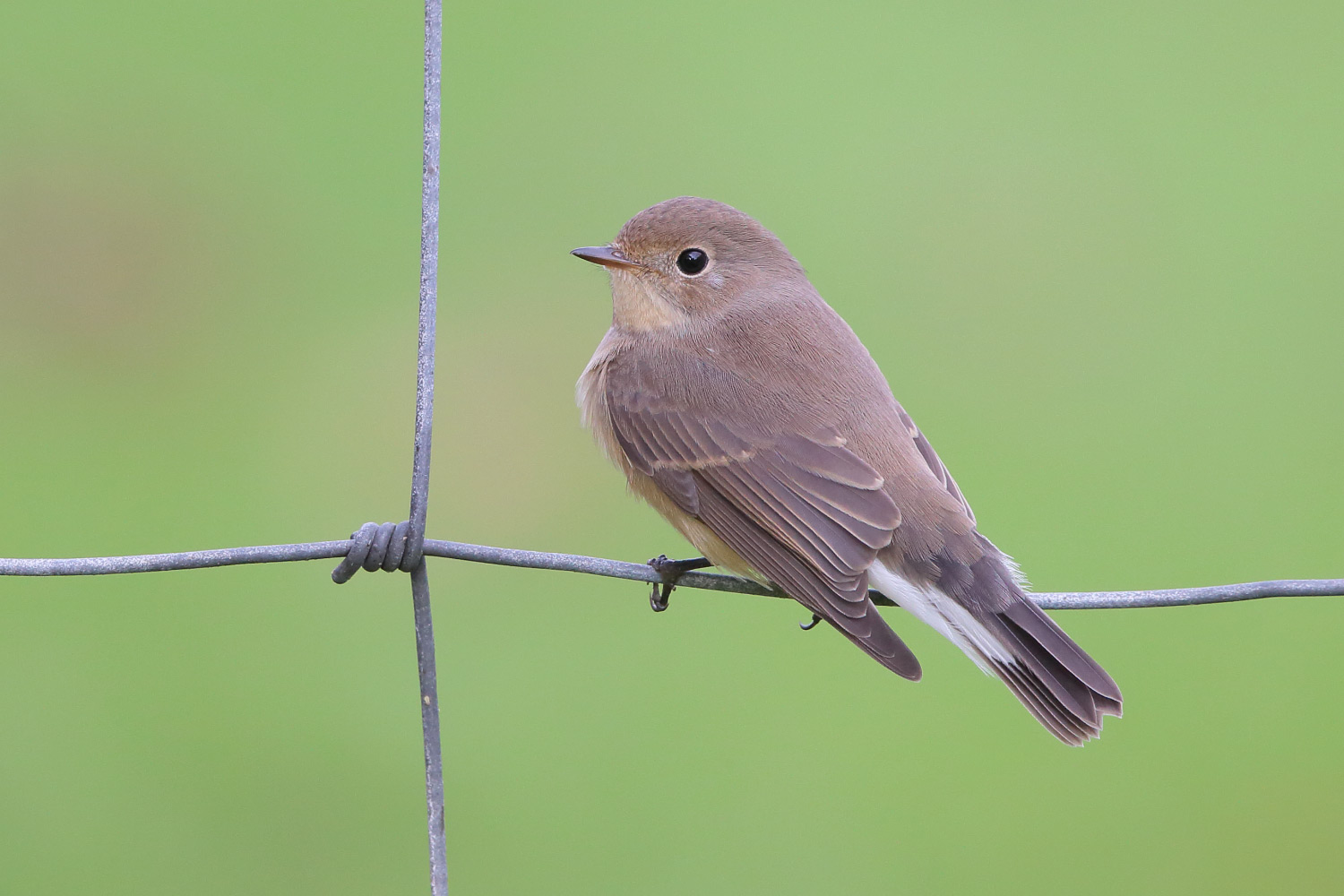
Red-breasted Flycatcher (Cunningsburgh, Shetland, 27 September 2014). Flycatchers are always a delight to encounter. This image shows a Red-breasted Flycatcher, not in its normal habitat of mature trees but as an autumn migrant on a Shetland barbed wire fence. Such out of context birds can, as here, provide exceptional views. Note on this bird the soft brown and peach hues, the relatively plain wing and, most importantly, the white 'panels' in the sides of the tail (James Lowen / www.jameslowen.com).
Spotted and Asian Brown Flycatchers
Spotted Flycatcher breeds from western Europe in the west to southern Siberia and Mongolia in the east, the whole population wintering in sub-Saharan Africa. Although a fast-declining breeding bird in Britain, it can also be found as an autumn migrant from the Continent, particularly on eastern coasts. This is a relatively early autumn migrant, with passage typically peaking in late August and September.
This is a large flycatcher, strikingly lean, long tailed and long winged. Its plumage is a characteristic mousey grey-brown, softly marked with blurry vertical streaking on the breast and at the throat-sides and with some streaking also in the forehead and crown. First-winter birds show some pale fringing and tipping in the tertials and greater coverts.
Asian Brown Flycatcher breeds across Siberia east to Sakhalin and Japan and winters in South-East Asia. It is an extreme rarity in Britain with only four records to date, all on the east coast, one in July and the others in September and October.
Asian Brown is plain and brown and so Spotted Flycatcher is the main confusion species, but in reality the differences are many. Asian Brown is a very small flycatcher, compact and short tailed. Its head is large looking and its eye also looks big. From below, the bill base is strikingly broad, almost 'boat shaped', and, unlike Spotted Flycatcher, extensively orange on the lower mandible. In terms of plumage, it is a uniform pale brown, unstreaked with almost no distinguishing features, although there is a diffuse brownish wash across the breast and a first-winter bird would show some pale fringing and tipping in the tertials and greater coverts. Most striking perhaps are the pale lores and large, staring eye with a prominent eyering.
Pied and Collared Flycatchers
Pied Flycatcher breeds from Iberia in the west to western Siberia in the east and winters in west Africa. It is a common breeder in parts of western Britian, but on the east coast it is perhaps best known as the quintessential Continental migrant. It is also an early migrant, peaking in August but still occurring in September.
This is a distinctive and easy-to-identify species. Its autumn plumage is a relatively plain mousey-brown, but the closed wing is dark with white in the tertial and wing covert edges (and often in the primary bases too) and a dark tail with prominent white outer tail feathers. A close view will reveal diffuse washes at the throat sides. This is a difficult species to miss as it can be both highly active, performing a characteristic single wing-flick, and noisy, giving a nervous and quite loud whit whit.
Its sibling species – Collared Flycatcher – breeds through much of central and eastern Europe and parts of western Russia. It is very rare in Britain, with just 46 records to date; almost all of which are in spring. Only three have been found in autumn.
Although adult males are striking, in autumn this species presents one of the classic and most difficult identification problems. In reality, most will be verging on unidentifiable in the field. The only useful feature concerns the shape and extent of the white patch at the primary bases: lacking or very restricted in Pied and not approaching the leading edge of the wing, but longer and more 'club shaped' in Collared, extending beyond the tips of the primary coverts and almost to the wing edge. Other plumage features are only visible in the hand, and DNA analysis might also be useful. The call might be helpful, however: in Collared a soft, high-pitched heeep.
Red-breasted and Taiga Flycatchers
Red-breasted Flycatcher breeds in eastern Europe and western Russia and migrates south-east to the Indian subcontinent for winter. In autumn it is a regular though still very scarce migrant in Britain, mainly on the east coast.
This is a truly tiny and often very active flycatcher and has a distinctive habit of cocking its rather long tail, producing a somewhat Wren-like silhouette. Its plumage is warm brown above (with no white in the wing) and a warm buff or peachy colour below. The most striking feature is its tail pattern: this is blackish with prominent white panels at the base, very obvious in flight. This species can be noisy too, giving a very distinctive soft Wren-like rattle: trrrrk.
Its eastern counterpart – Taiga Flycatcher – is very similar; indeed it was until relatively recently regarded as its eastern subspecies. Taiga Flycatcher breeds across Siberia and winters in South-East Asia. It is an extreme rarity in Britain, with only three records to date, one in April and the others in September and October.
This species is challenging to identify, but tends to be a colder, greyer colour than Red-breasted, particularly on the underparts which lack warm, peachy hues. The tertials differ too, being more prominently pale fringed, and the bill averages darker than Red-breasted Flycatcher. The key feature, however, is the colour of the uppertail coverts: brown or near-black in Red-breasted (never blacker than the central tail feathers), but a deep glossy black (blacker than the central tail feathers) in Taiga. Calls are useful, too. Taiga Flycatcher gives a rattle call like Red-breasted but it is drier, faster and harsher.

Spotted Flycatcher (Spurn, East Yorkshire, 29 September 2007). This Spotted Flycatcher is typically long and sleek with very long wings and a relatively long tail, longer than that of Brown Flycatcher. The blurry streaking on the breast and flanks and also on the forehead and crown are diagnostic of Spotted Flycatcher. Note also the lack of prominent pale lores, the relatively small-looking eye and the wholly dark-looking bill. The obvious pale tips to the wing coverts indicate that this is a fresh first-winter bird (Steve Young / www.birdsonfilm.com).
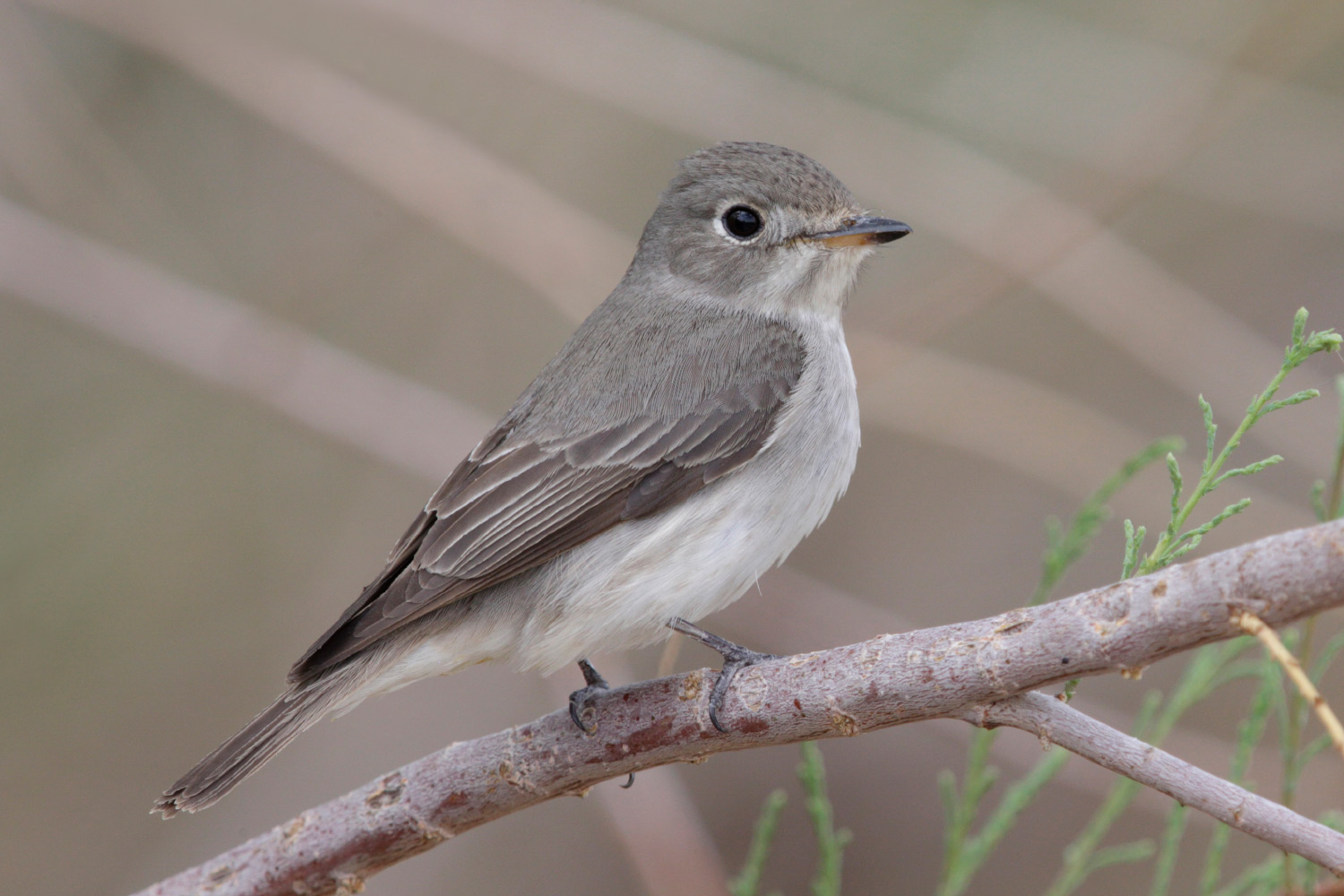
Asian Brown Flycatcher (Mongolia, 30 May 2014). This mousey-brown bird might at first sight be taken for a Spotted Flycatcher, but the underparts are completely plain, lacking any blurry streaking on the breast and flanks, and the forehead and crown are completely plain, too. As well as its striking uniformity, note the small-looking size and the compact, short-tailed proportions with a relatively large-looking head and eye and a stout, broad-based bill with extensive orange in the lower mandible. Also obvious are a prominent eyering and a large pale triangular area on the lores (Mike Danzenbaker / www.agami.nl).
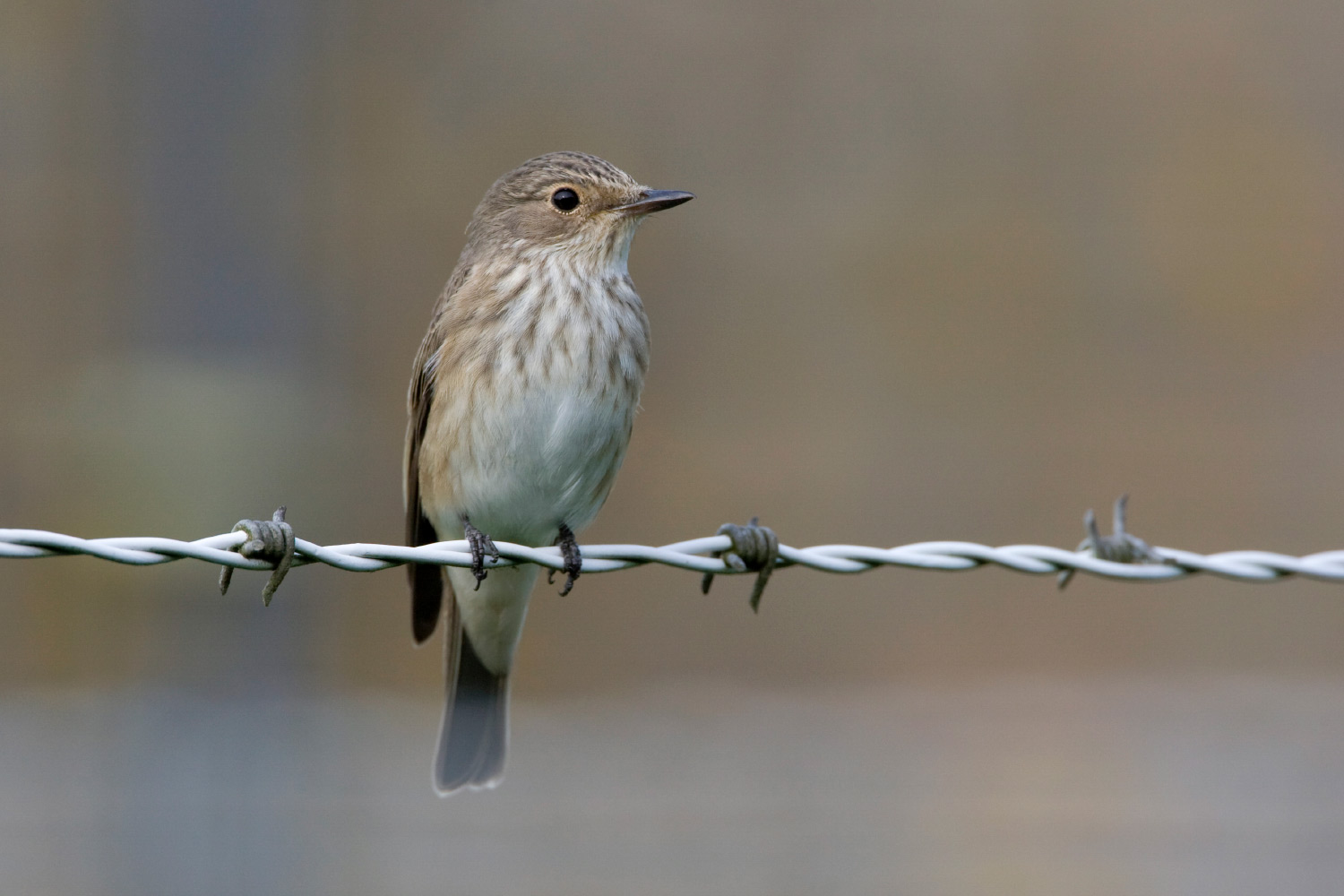
Spotted Flycatcher (The Netherlands, 17 September 2008). The diffuse streaking on the breast, flanks, forehead and crown are plain to see and identify this bird as a Spotted Flycatcher. Note again the small-looking eye and lack of obvious pale lores, while the bill also appears nearly completely dark, lacking extensive orange in the lower mandible (Arie Ouwerkek / www.agami.nl).

Asian Brown Flycatcher (Flamborough Head, East Yorkshire, 4 October 2007). There are few features visible in this head-on shot and this bird could at first glance be one of several flycatchers. However, the very large-looking eye, prominent eyering and extensively and contrastingly pale lores should grab the attention. Further views should then reveal the complete suite of Asian Brown Flycatcher characters (Steve Young / www.birdsonfilm.com).
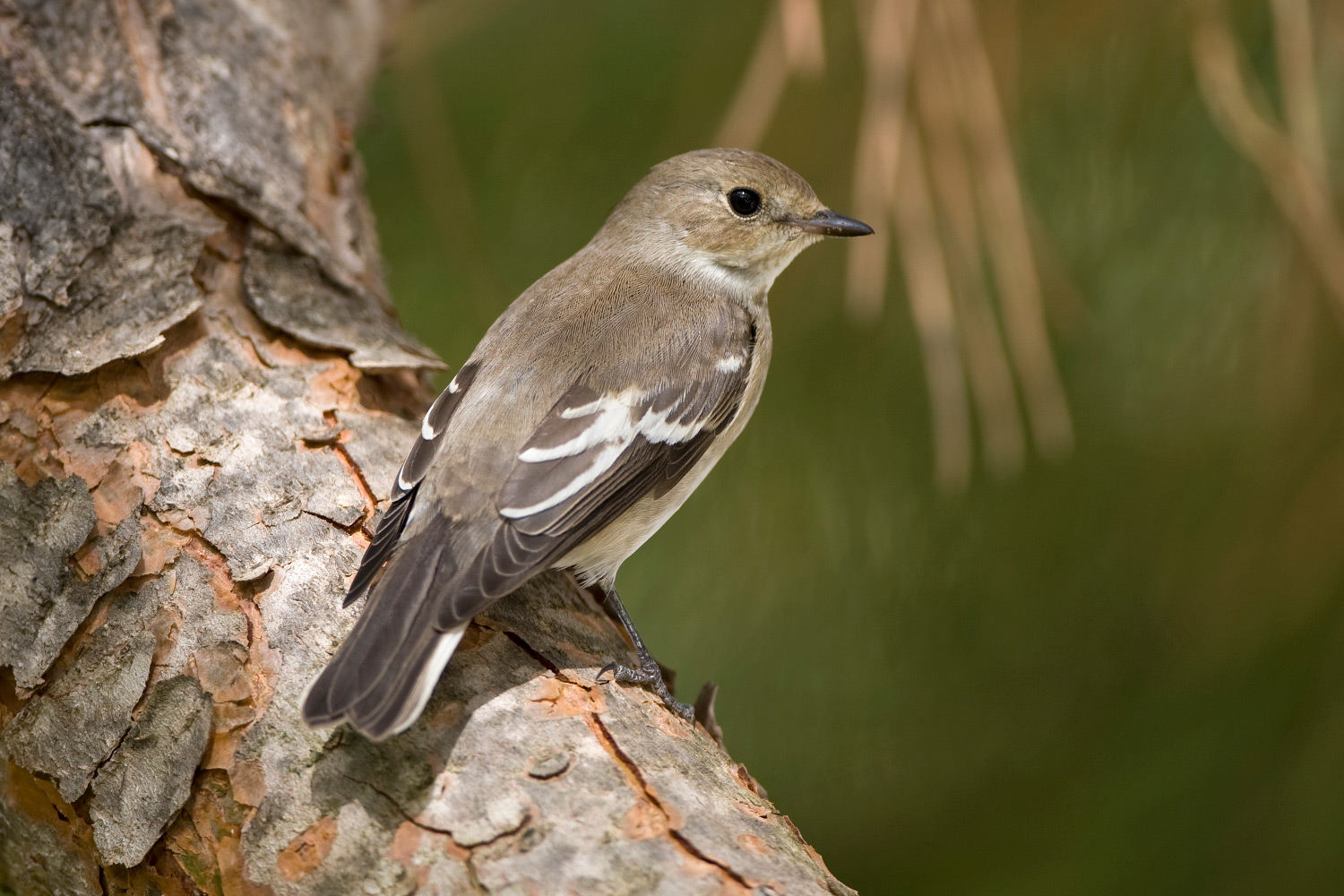
Pied Flycatcher (Algarve, Portugal, 6 September 2007). The prominent white edges to the tertials and white tips to the wing coverts readily identify this bird as a Pied Flycatcher. Note also the contrastingly dark tail with white outer tail feathers. In life, migrant Pied Flycatchers can be noisy – giving a loud whit – and also perform a distinctive nervous wing flicking (Robin Chittenden).
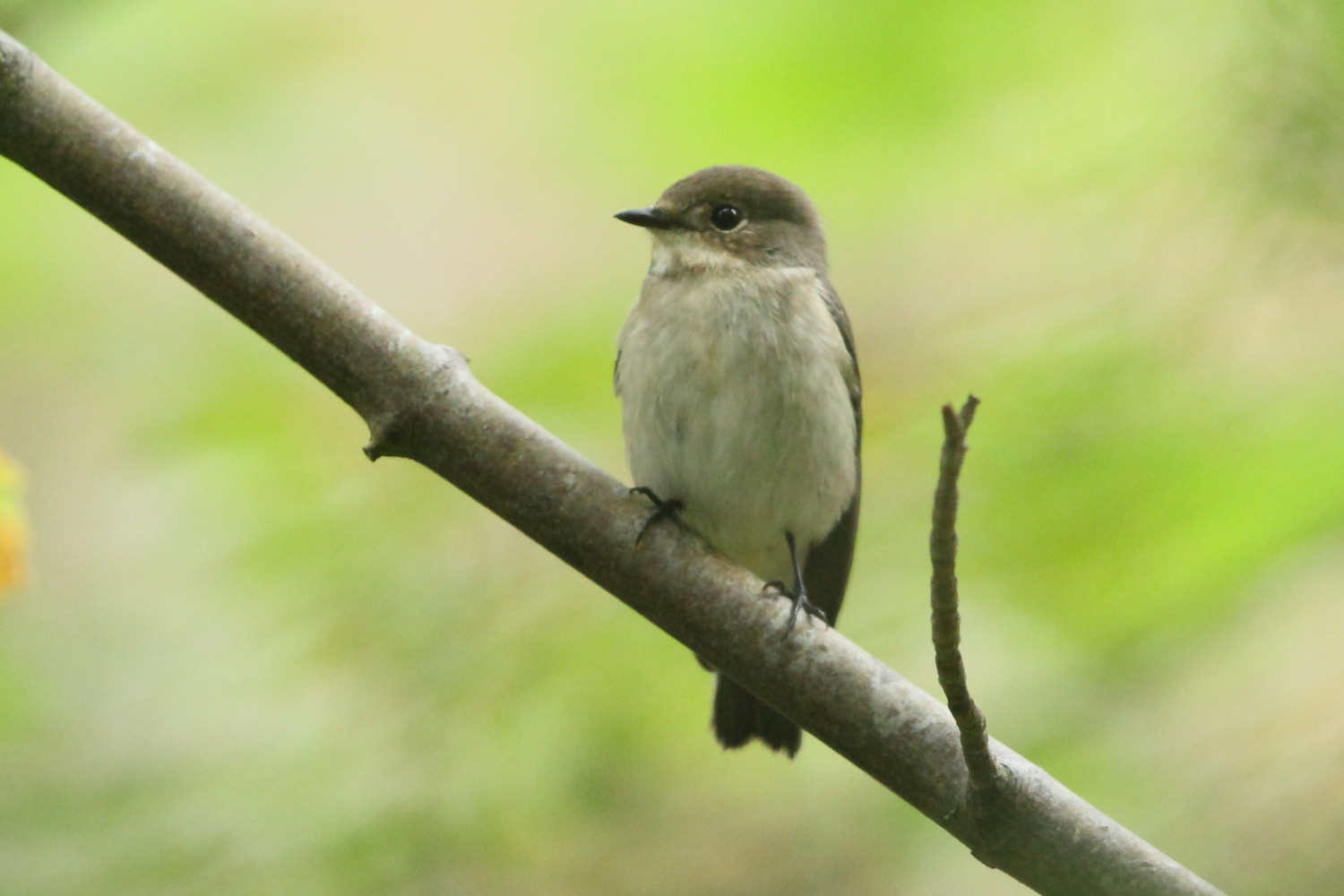
Pied Flycatcher (Wells, Norfolk, 19 September 2016). This head-on flycatcher presents few clues and could at first sight be one of several species discussed here. However, the plain underparts and forehead and crown eliminate Spotted Flycatcher, while the lack of prominent pale lores and weak eyering suggest Pied Flycatcher. The malar 'smudge' is also typical of this species. Further views of the upperparts should show the characteristic white wing markings (James Lowen / www.jameslowen.com).
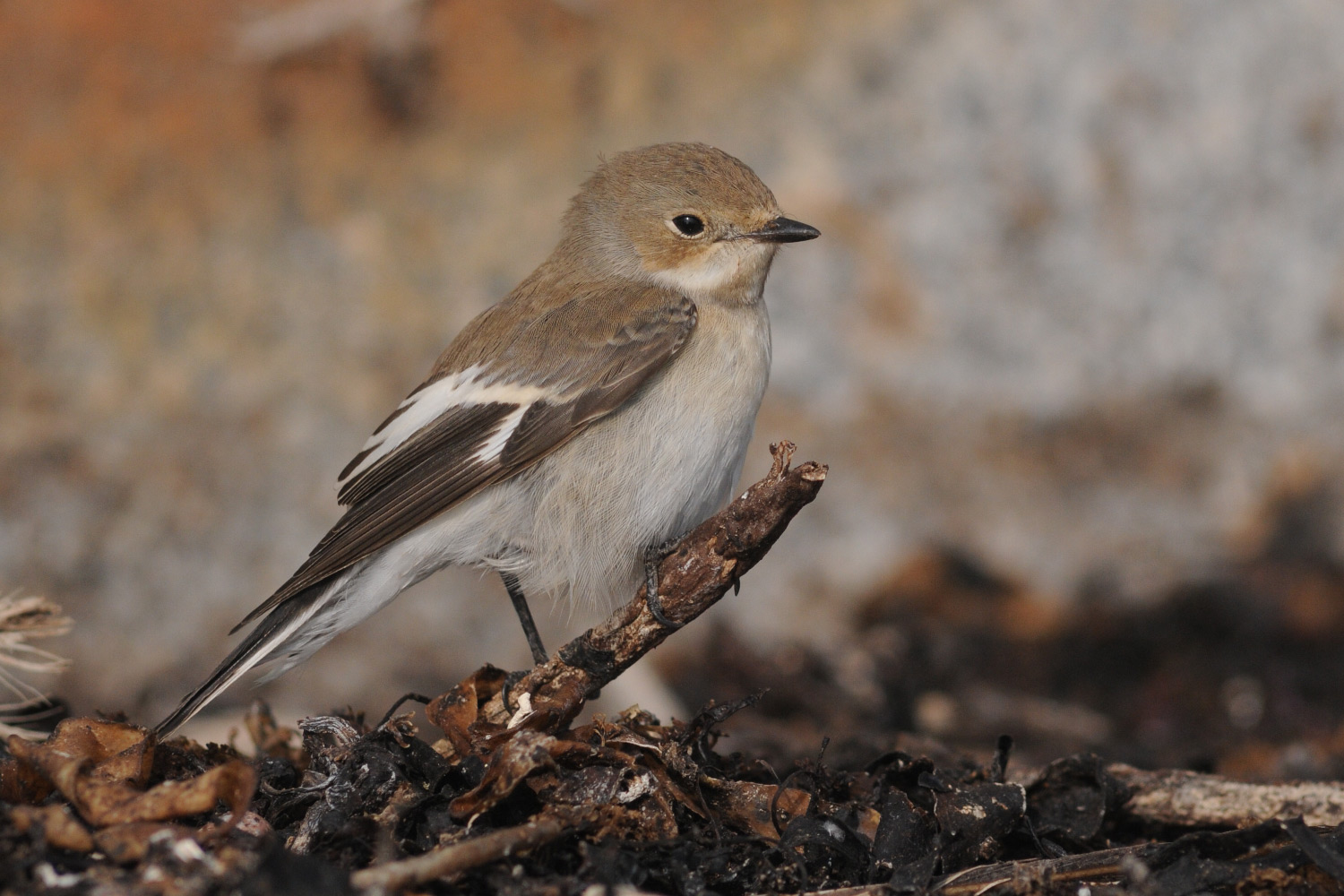
Collared Flycatcher (Heligoland, Germany, 27 September 2008). This bird closely resembles a Pied Flycatcher. The white tertial edges and covert tips and dark tail with white outer tail feathers are all typical of that species. However, the patch at the base of the primaries is strikingly large and 'club shaped', extending down beyond the tips of the primary coverts and forward towards the leading edge of the wing. A white patch at the primary bases is shown by many Pied Flycatchers but the one on this bird is beyond the range of Pied and is a key pointer to Collared Flycatcher (Roef Mulder).
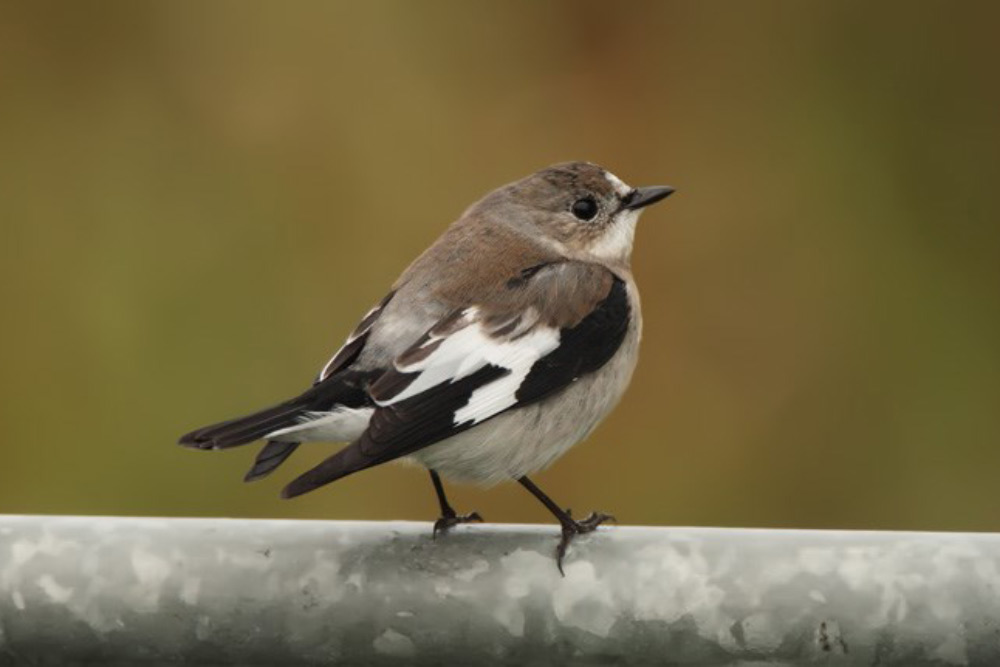
Collared Flycatcher (Sumburgh, Shetland, 21 September 2015). Most autumn Collared Flycatchers resemble the bird in the previous image, but adult males can, as here, be much more striking. Note the continued presence of a large white forehead patch, larger than that of Pied, and massive amounts of white in the tertials and wing coverts and, most importantly, in the primary bases. The white here is so extensive, resembling that of several shrike species, that this bird can only be a Collared Flycatcher (Steve Arlow).
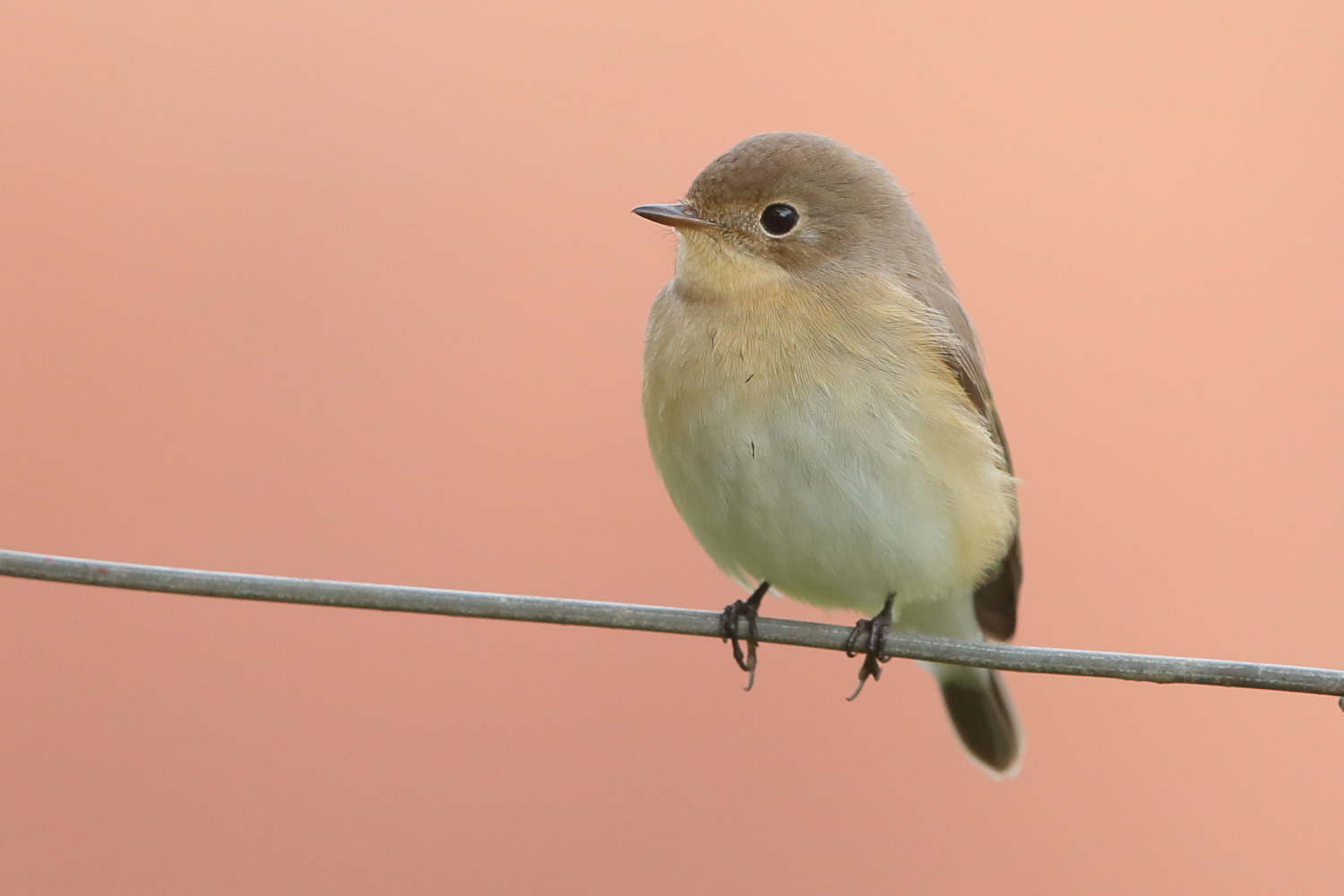
Red-breasted Flycatcher (Cunningsburgh, Shetland, 27 September 2014). Head-on flycatchers can be tricky and this bird could at first sight be taken for a Pied Flycatcher. However, the rich peachy hues in the throat and breast and the lack of a subtle malar 'smudge' identify this as a Red-breasted Flycatcher. In life, the plain wings and white tail 'panels' would rapidly become apparent, as would a persistent tail-cocking habit and a Wren-like 'rattling' call (James Lowen / www.jameslowen.com).
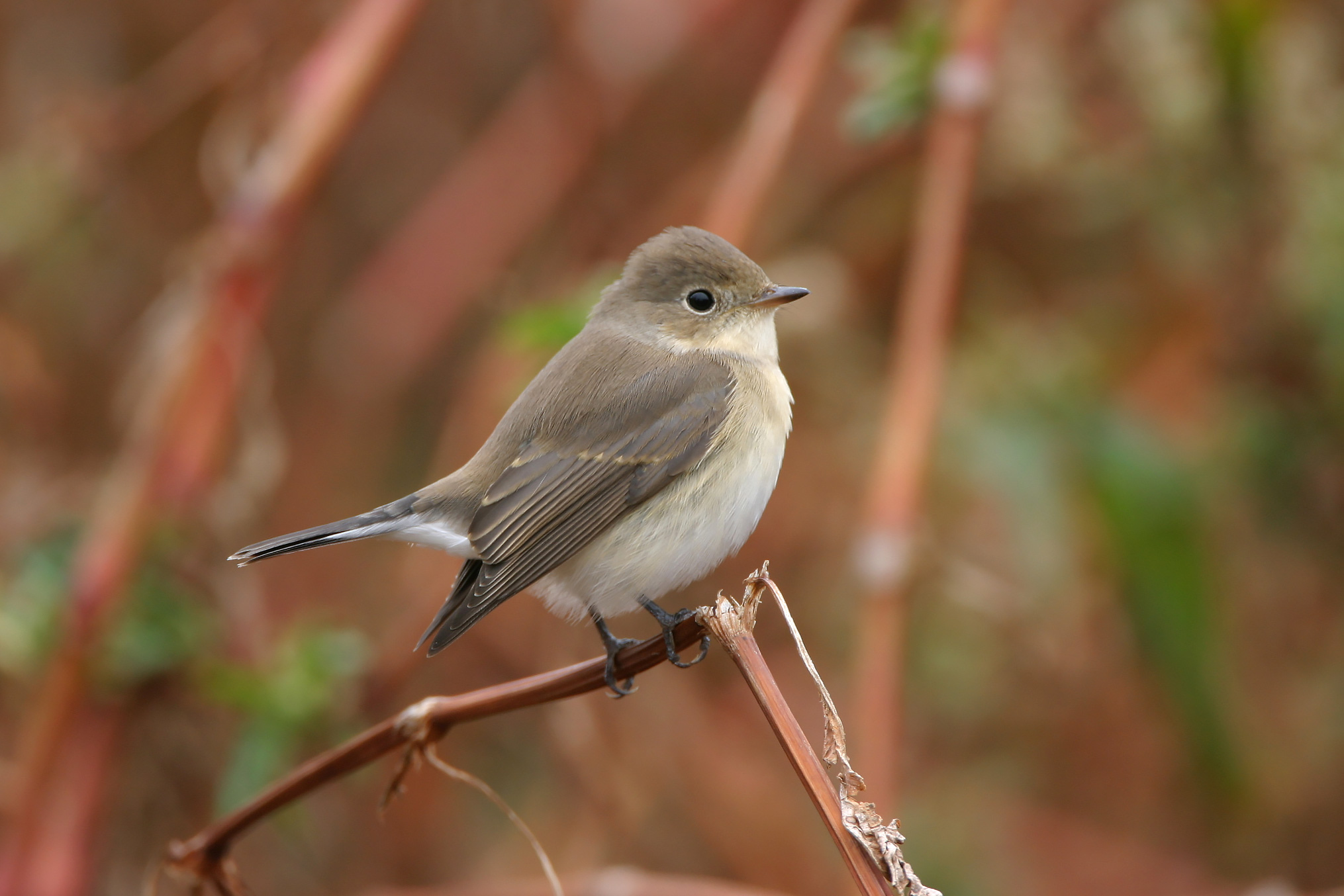
Red-breasted Flycatcher (Heligoland, Germany, 8 October 2005). This mousey-brown flycatcher lacks any white in the wing, so cannot be a Pied or Collared Flycatcher, and its uniformity also eliminates Spotted Flycatcher. Its small size and compact proportions recall Asian Brown Flycatcher, but note the lack of a prominent pale triangular loral patch. The white 'panels' in the tail are just visible here and readily identify this as a Red-breasted Flycatcher. The cocked tail is also characteristic of this species (Bas van den Boogaard / www.agami.nl).
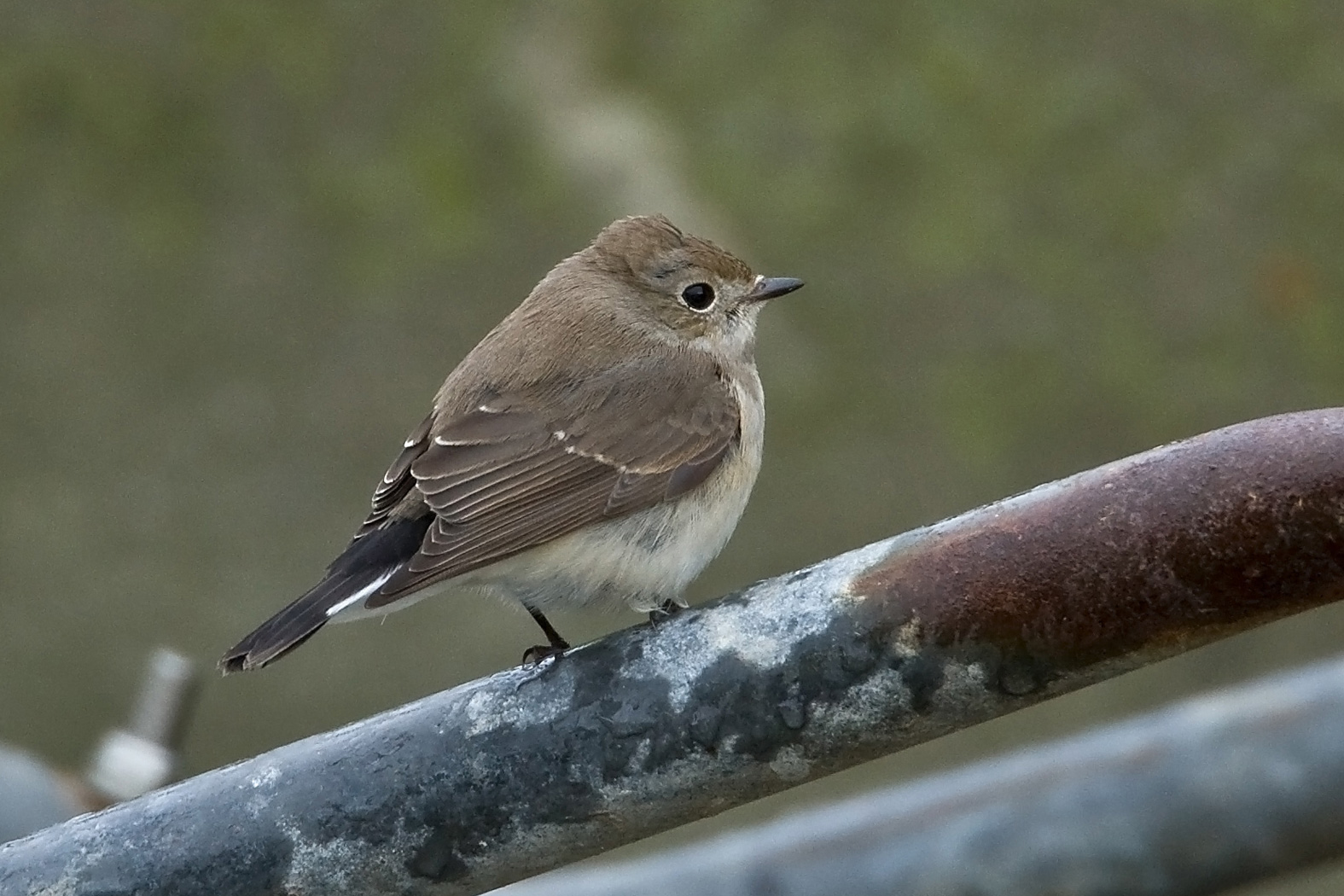
Taiga Flycatcher (Yell, Shetland, 18 October 2009). With its white tail 'panels', this bird closely resembles a Red-breasted Flycatcher. However, most Red-breasted Flycatchers are quite a warm brown and many show peachy hues in the throat and breast. By contrast, this bird looks strikingly 'cold' – grey-brown above and whitish below. This appearance is a strong pointer towards Taiga Flycatcher, but to confirm its identity we need to look at the uppertail coverts. Here they are reassuringly solid black, slightly blacker even than the tail itself (John Carter).

Taiga Flycatcher (Fetlar, Shetland, 27 September 2009). The same bird as in the previous photo, at its original site when first identified. With its compact proportions and dark tail with white side 'panels', this bird closely resembles a Red-breasted Flycatcher. However, it is a rather 'cold' grey-brown above and white below and there are no peachy hues in the throat or breast. This should set alarm bells ringing as these are key features of Taiga Flycatcher (Dominic Mitchell / www.birdingetc.com).
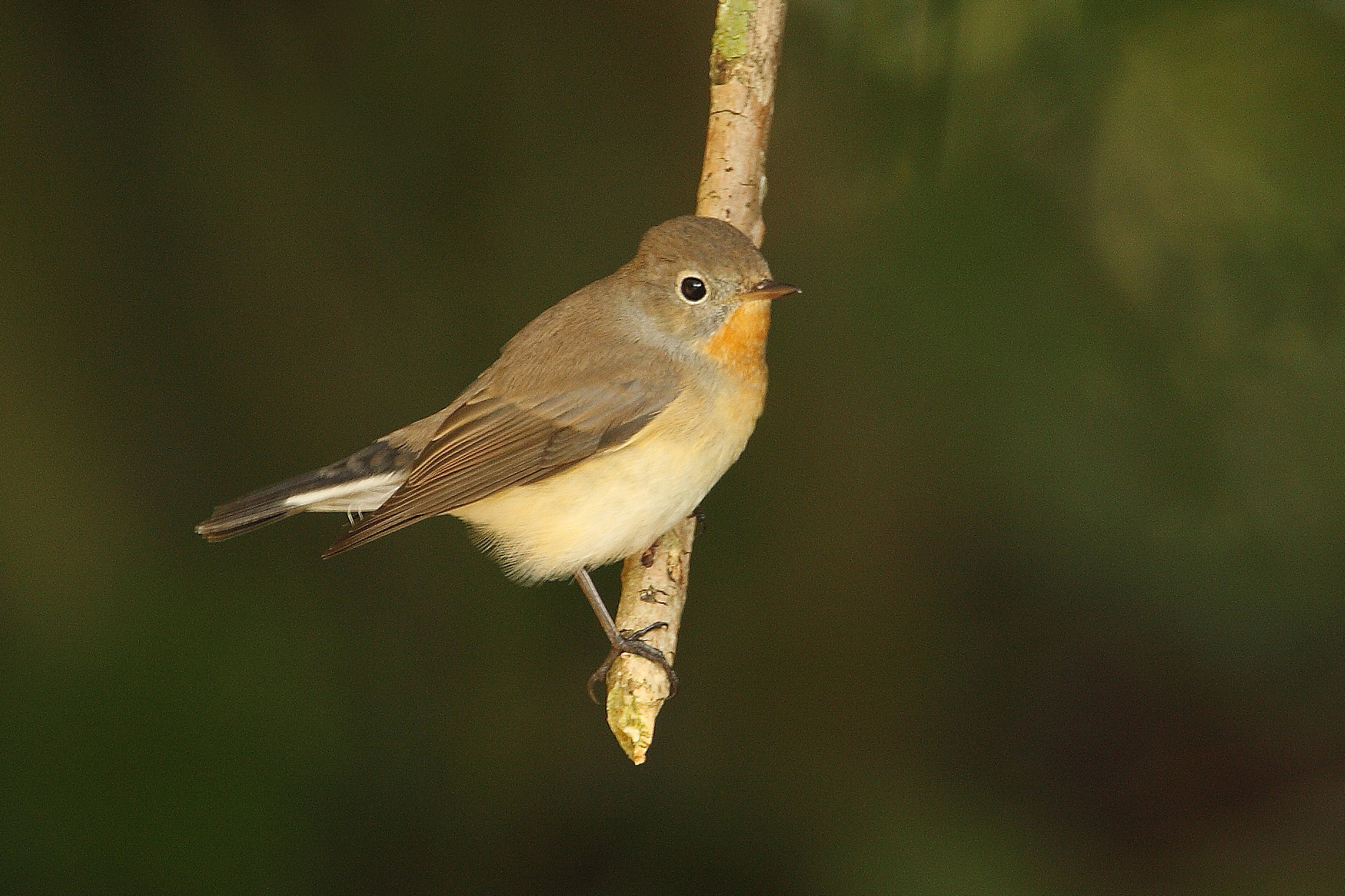
Red-breasted Flycatcher (Spurn, East Yorkshire, 25 September 2008). Autumn adult male Red-breasted Flycatchers retain their orange throat, which suffuses softly into the upper breast. Also visible clearly are the 'warm' brown plumage hues, half-cocked tail and white tail 'panels'. Note that the uppertail coverts, although blackish, are not fully jet black and are not blacker than the tail (John Dickenson).
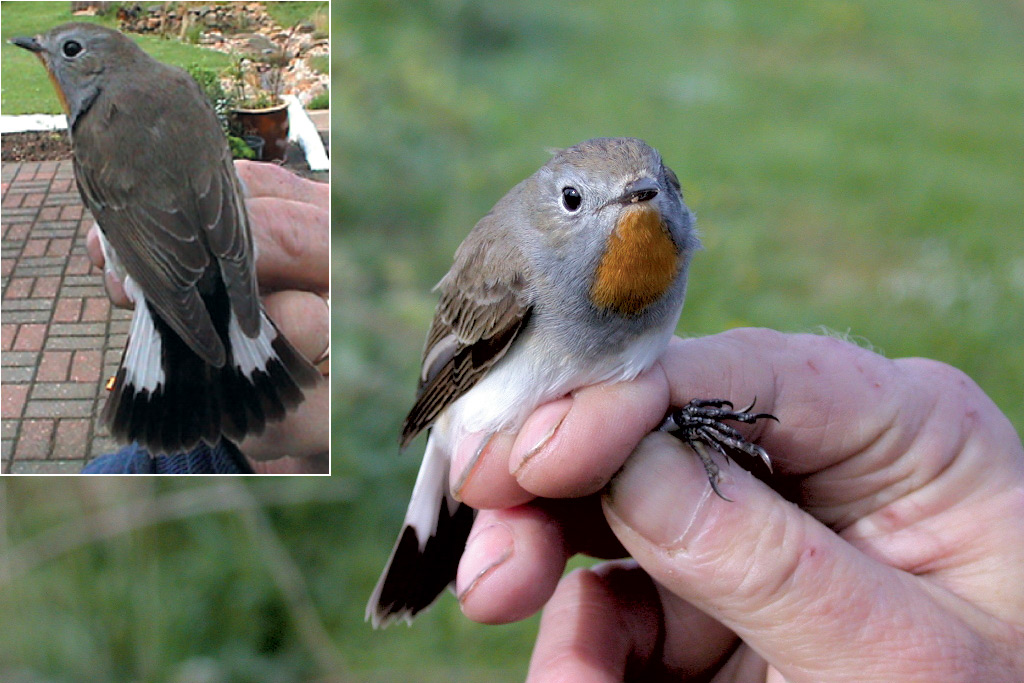
Taiga Flycatcher (Flamborough Head, East Yorkshire, 26 April 2003). This Taiga Flycatcher was Britain's first. Note the 'cold' hues in the upperparts and very white-looking underparts. Most striking, however, is the sharply defined orange throat patch encircled by a solid band of ash-grey at the throat-sides and across the breast. The pale tips to the greater coverts identify this as a second-calendar-year bird; this is a further pointer to Taiga Flycatcher. Male Taigas acquire an orange throat in their second year, while male Red-breasted Flycatchers don't do so until their third (Andrew Lassey and (inset) Brett Richards).
- This article was originally published in the September 2017 issue of Birdwatch magazine.








